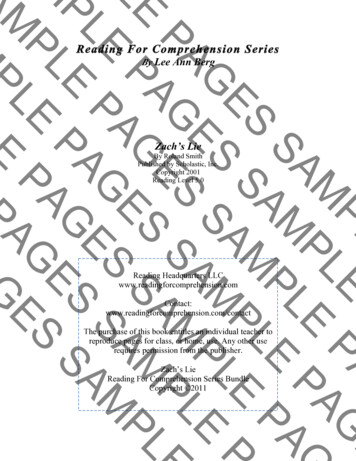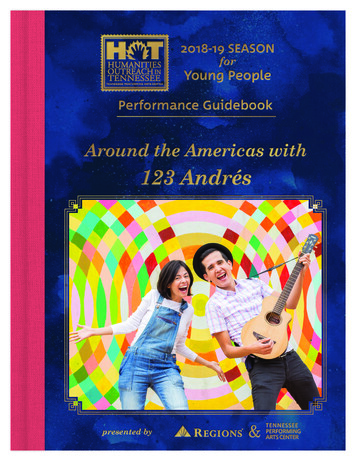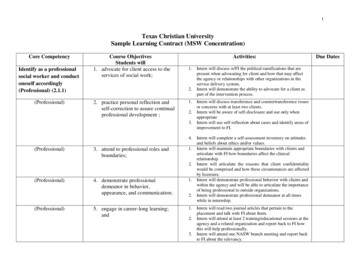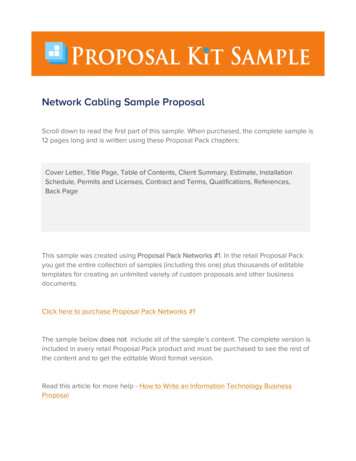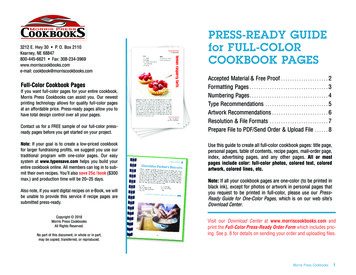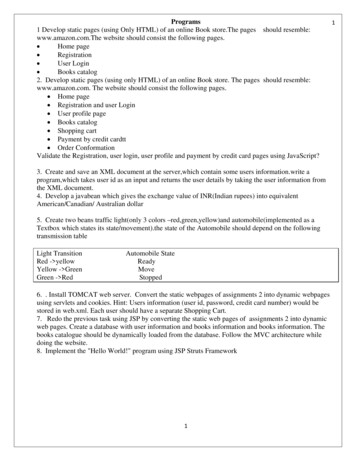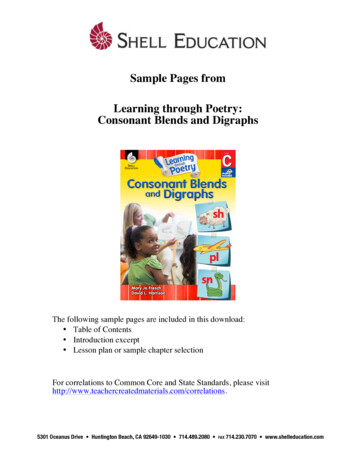
Transcription
Sample Pages fromLearning through Poetry:Consonant Blends and DigraphsCLevelLevelCt5JUMF QU 6QQFS -PXFS DBTF t CDs tMary Jo FreschMaryDavidJo FreschL. HarrisonDavid L. HarrisonThe following sample pages are included in this download: Table of Contents Introduction excerpt Lesson plan or sample chapter selectionFor correlations to Common Core and State Standards, please ations.5301 Oceanus Drive Huntington Beach, CA 92649-1030 714.489.2080 FAX714.230.7070 www.shelleducation.com
CLevelAudioIncludedMary Jo FreschMaryDavidJo FreschL. HarrisonDavid L. Harrison
Table of ContentsIntroduction. . . . . . . . . . . . . . . . . . . . . . . . . . . . . . . . . . . . . . . . . . . . . . . . . . . . . . . . . . . . 4How to Use This Book. . . . . . . . . . . . . . . . . . . . . . . . . . . . . . . . . . . . . . . . . . . . . . . . . . 12Correlation to Standards . . . . . . . . . . . . . . . . . . . . . . . . . . . . . . . . . . . . . . . . . . . . . . 18Poems and Lessons. . . . . . . . . . . . . . . . . . . . . . . . . . . . . . . . . . . . . . . . . . . . . . . . . . . . 22Blend Bl. . . . . . . . . . . . . . . . . . . . . . . . . . . . . . . . . . . . . . . . . . . . . . . . . . . . . . . . . . . . . . 22Blend Br . . . . . . . . . . . . . . . . . . . . . . . . . . . . . . . . . . . . . . . . . . . . . . . . . . . . . . . . . . . . . 27Blend Cl. . . . . . . . . . . . . . . . . . . . . . . . . . . . . . . . . . . . . . . . . . . . . . . . . . . . . . . . . . . . . . 32Blend Cr . . . . . . . . . . . . . . . . . . . . . . . . . . . . . . . . . . . . . . . . . . . . . . . . . . . . . . . . . . . . . 37Blend Fl. . . . . . . . . . . . . . . . . . . . . . . . . . . . . . . . . . . . . . . . . . . . . . . . . . . . . . . . . . . . . . 42Blend Fr. . . . . . . . . . . . . . . . . . . . . . . . . . . . . . . . . . . . . . . . . . . . . . . . . . . . . . . . . . . . . . 47Blend Gr. . . . . . . . . . . . . . . . . . . . . . . . . . . . . . . . . . . . . . . . . . . . . . . . . . . . . . . . . . . . . 52Blend Pl. . . . . . . . . . . . . . . . . . . . . . . . . . . . . . . . . . . . . . . . . . . . . . . . . . . . . . . . . . . . . . 57Blend Sl. . . . . . . . . . . . . . . . . . . . . . . . . . . . . . . . . . . . . . . . . . . . . . . . . . . . . . . . . . . . . . 62Blend Sn. . . . . . . . . . . . . . . . . . . . . . . . . . . . . . . . . . . . . . . . . . . . . . . . . . . . . . . . . . . . . 67Blend Sp. . . . . . . . . . . . . . . . . . . . . . . . . . . . . . . . . . . . . . . . . . . . . . . . . . . . . . . . . . . . . 72Blend St. . . . . . . . . . . . . . . . . . . . . . . . . . . . . . . . . . . . . . . . . . . . . . . . . . . . . . . . . . . . . . 77Digraph Ch . . . . . . . . . . . . . . . . . . . . . . . . . . . . . . . . . . . . . . . . . . . . . . . . . . . . . . . . . . 82Digraph Sh. . . . . . . . . . . . . . . . . . . . . . . . . . . . . . . . . . . . . . . . . . . . . . . . . . . . . . . . . . . 87Digraph Th. . . . . . . . . . . . . . . . . . . . . . . . . . . . . . . . . . . . . . . . . . . . . . . . . . . . . . . . . . . 92Digraph Wh. . . . . . . . . . . . . . . . . . . . . . . . . . . . . . . . . . . . . . . . . . . . . . . . . . . . . . . . . . 97References Cited. . . . . . . . . . . . . . . . . . . . . . . . . . . . . . . . . . . . . . . . . . . . . . . . . . . . . . 102Answer Key. . . . . . . . . . . . . . . . . . . . . . . . . . . . . . . . . . . . . . . . . . . . . . . . . . . . . . . . . . . 104Content Connection Matrix. . . . . . . . . . . . . . . . . . . . . . . . . . . . . . . . . . . . . . . . . . . 106Contents of the CDs. . . . . . . . . . . . . . . . . . . . . . . . . . . . . . . . . . . . . . . . . . . . . . . . . . . 107Meet the Authors. . . . . . . . . . . . . . . . . . . . . . . . . . . . . . . . . . . . . . . . . . . . . . . . . . . . . 110 Shell Education #50974—Learning through Poetry: Consonant Blends and Digraphs3
How to Use This BookTeaching the LessonsTo learn to read is to light a fire; every syllable that is spelled out is a spark.—Victor HugoThe poems and activities in this book provide lessons for students who are moving fromphonemic awareness to phonological awareness. For children still developing phonemicawareness, the lessons will encourage them to hear and play with sounds. For childrenready for phonological activities, the lessons will encourage them to point out whichletters and letter combinations make the sounds they hear in words. Additionally, thestudent activity sheets can allow children the opportunity to utilize their knowledge ofsounds and print.This book was designed with a foundation of integrating sound into the classroom. Wehope you will find it helpful for students who are hearing and manipulating sounds tostudents ready to match sounds and print. Once you have selected a poem, you candecide which type of phoneme activity you want your students to engage in. Thereare five sound manipulation activities for every poem. These activities are a naturalway to differentiate your instruction. You may have a small group of children who needadditional practice with just sound matching. You may also create a small group ofchildren ready to match sounds and print—phonics instruction. You can use the providedactivity as well as the activity sheet to support these students. Your close observations ofhow the children participate in the sound manipulations will guide your decision to reviewthe sound activities or expand their experiences into paper-and-pencil work.As an optional way to enhance each individual poetry lesson, copy the poems for eachstudent to keep as a personal, year-long collection in a pocket folder or a three-ringbinder. Once you have completed the poem together, you may want to display it atlearning centers, or on the bulletin board, to encourage the children to revisit it often.The table on the following page provides an overview of the five sound manipulationactivities that are provided with each poem in this book.12#50974—Learning through Poetry: Consonant Blends and Digraphs Shell Education
How to Use This BookTeaching the Lessons (cont.)Sound Manipulation Activities OverviewPhoneme (Sound) MatchingIn a lesson of sound matching, the children listen for a specific beginning sound. Forexample, they might listen to “Fraidy Cat Frank” (page 49) and hear the /fr/ sound at thebeginning of several words in the poem. You then ask the children which words fromthe poem do and do not begin with the /fr/ sound.Phoneme (Sound) IsolationIsolation lessons ask the children to listen for a specific sound within a given word. Forexample, when reading “Grandmas” (page 54) you can choose any word and ask, “Whatis the first sound in greasy? What is the first sound in growl? In grubs?”Phoneme (Sound) BlendingThe next level of manipulation is blending. In this type of activity, we break a word intoits separate phonemes and ask children to blend what they hear into the completeword. When saying words aloud to children, keep in mind that you want to slowlystretch the word to help them hear all the phonemes. For example, in “Croc andCricket” (page 39), you could stretch out the word crab in two different ways: /k/ /r/ /a//b/ or /kr/ /ab/. You may also want to point to the word in the poem as you stretch it sothat students who are reading can follow along with the print as you blend the sounds.Phoneme (Sound) SubstitutionUsing a poem such as “Fly and Flea” (page 44), we ask children to listen to how the firstletter(s), or onset, of the word is the same in words like flea, flew, and flap. Then, we askthem to change the onset to make new words not already in the poem. They mightsuggest tea, blew, or cap. These can be written on the board or chart paper to facilitatelearning for children developing phonological awareness.Sound SegmentationIn sound segmentation, ask children to do the opposite of what they did in blending.That is, ask them to take a word (stop) and tell us what sounds make up the word(/s/ /t/ /o/ /p/). You can do this by saying a word aloud for those children not yetreading print or by pointing to the word for your beginning readers. Ask children tostretch the sounds they hear. We often use the analogy of stretching a rubber band tohelp us slowly say the word. Shell Education #50974—Learning through Poetry: Consonant Blends and Digraphs13
How to Use This BookTeaching the Lessons (cont.)This book presents 16 blends and digraphs poems. Each poem in this book focuseson consonant blends (where each consonant maintains its sound, but the two or threeletters are blended together as in the letters bl or fl) or consonant digraphs (where twoconsonants create a new sound as in the letters ch, sh, or th).A Closer Look at Blends and DigraphsConsonant BlendsSoundor Digraphsbl, br, cl, cr, fl, fr, gr, pl, sl, each consonant maintains its own sound, but the twosn, sp, st,consonants are blended as we pronounce words.thsecond most frequently occurring digraph (/ng/ isthe most frequently occuring digraph); Two sounds—voiced /th/, as in this, than, and those, and voiceless /th/, as in thing, thaw, and monthchthird most frequently occurring digraph; Eighty-ninepercent of the time sounds like /ch/ as in church; tenpercent of the time sounds like /k/ as in chaos (wordsof Greek origin); one percent of the time sounds like/sh/ as in che (words of French origin)shfourth most frequently occurring digraph; Consistentin sound of /sh/whninety percent of the time digraph sounds like /wh/ asin wheel, where, and whiskers; ten percent of the timedigraph sounds like /w/ as in what, why, and when;the /wh/ phoneme is never at the end of a word14#50974—Learning through Poetry: Consonant Blends and Digraphs Shell Education
How to Use This BookTeaching the Lessons (cont.)Building Phonemic Awareness SkillsBlendSlIn the “Building Phonemic Awareness Skills” section, eachsound manipulation activity suggests which words in thepoem can be used for practice. Plan on spending about10 minutes for each phonemic awareness activity andconsider spreading the five manipulations over severaldays, reviewing the ones you already introduced.Materials “Slippery” (page 64; Audio CD: Track 09) chart paper (optional)ProcedurePreparation Note: Distribute copies of the poem “Slippery” (page 64) to students ordisplay a large version of the poem on chart paper. Read the poem aloud or play theprofessional recording of the poem, and then proceed to the steps below.1. Sound Matching—Say to students, “Listen to these three words from the poem:sleeping, slushy, down. Which have the same sounds at the beginning? Listen tothese three words from the poem: red, faster, sled. Which have the same sound atthe end?”2. Sound Isolation—Ask students, “What are the first sounds in the word slick?What are the first sounds in the word slam? In slug?” Ask, “What other wordsbegin with /sl/?”3. Sound Blending—Ask students, “What word is /sl/ /ice/? What word is /sl/ /ed/?”4. Sound Substitution—Ask students, “What word would I make if I change/sl/ to /b/ in sled? If I change /sl/ to /b/ in slug?”5. Sound Segmentation—Ask students, “If you stretch the word sled, what soundsdo you hear? Stretch slug, what do you hear?”Building Phonics SkillsMaterials poem and activity page (pages 64–65) chart paper (optional)Suggestions are made for those students ready toconnect print and sound in the “Building Phonics Skills”section. These students can also be given the activitysheet to extend their experience working with consonantsounds in print.ProcedurePreparation Note: Distribute copies or display a large version of the poem “Slippery”(page 64) and distribute Perfect Fit (page 65) to students. Read the poem aloud or playthe professional recording of the poem, and then proceed to the steps below.1. Write the word sled on the board. Ask, “What word would I make if I changesl to b in sled?” Erase the letters sl, and write the letter b to make the new word.Ask, “Were we right in our prediction about what the new word would be?”2. Demonstrate this with other words such as fed, led, and red.3. Write the word sled on the board. Say, “Look across the word and tell me all thesounds you hear,” or say, “Stretch the sounds as you read the word.”4. Repeat the activity with the word slug. Have students complete the activity pagefor additional practice.62#50974—Learning through Poetry: Consonant Blends and Digraphs Shell EducationCross-curricular connections expand the use of a singlepoem into multiple contexts. The “Content Connections”section of the lesson helps relate the poems to othereducational areas such as mathematics, social studies,or science, while the art section (located on the DigitalResource CD) provides connections in dance, music, artsand crafts, drama, and movement.tionsContent ConnecBlendSlScienceMaterialsl days pictures of snowa bread pan severa(freeze water inside block of iceof time) cheese grateraheadr,They are wintein a year.e:thisfour seasons Namtakespoemthat there aren). Explain that1. Tell studentsand fall (autumDate:spring, summer,r.s withplace in wintein the winter, discussnow (in thesnowhasthatthean areado outside in2. If you live inof things you canstudents the sorts ng).sleddipictures of whatsomepoem, he goeshavelive,you Directionhave snow wherethe snow. s: Fit the slwords into the3. If you do not and activities you can do inure (rain) is frozenboxes below.snow looks likecold enough, moistthe icewhen the sky gets becomessnow. Removeslick4. Discuss howslowthe ground andslugbefore it falls tosloththe ice andslidetakingfrom the pan.bysledhow snow feelshow it feelsnts an idea ofhands. Discusstheirover5. Give studecheese graterrubbing it on ait.ns as they holdand what happeResource CDsee the DigitalArtplease,lessony supporting thisFor an art activit).(artblendsl.pdfProcedurePerfect FitssBlendSll l uue ConnectionSchool and HomThe “School and Home Connection” contains a letterfor children’s families, explaining the lesson’s poem andsuggesting an activity for completion at home. A copyof the poem should be sent home along with the letter.Each poem is provided within the lesson, ready for you tophotocopy and enlarge as you see fit.Procedureletter.poem to the family1. Attach thetheir papers, asknts return withy ideas.2. When studetheir snow activitthem to shared.learnethey3. Discuss whatMaterials64) “Slippery” (pagefor Family Letter66)Blend Sl (pageing through Poetry:#50974—Learnion Shell EducatConsonant Blends Shell Education63and Digraphs#50974—Learning through Poetry:Consonant Blendsand Digraphs65BlendSlerySlippL. HarrisonBy Davidinh me sleepingYou won’t catc.or sloth in bedLike some slugslushy driftsughthrosliceI slam andad.instehillSliding down aFamily Letterfor BlendSlDear Families,This week, weread the poem“Slippery.” Enjoyyour student!reading it together withWe have also beenlearning about weather. Ourus on a sled inpoem this weeksnow. We talkedtookabout winter andcountry get snowhow some parts. Talk with yourof thestudethings we do during wintertime wher nt about the kinds of weather andideas and returne we live. Belowthis to school, please sharetomorrow.yourSincerely,faster, faster,Slow at first bute red,Scarf flying, nosery slopesDown slick, slipp.k, slender sledsleemyslideIIn the winter,Consonant Blendsand DigraphsFor usewith eitherMacintosh orWindows orMP3-compatibleCD playersSEP 51111we like to:Audio CD—Level CConsonant Blendsand DigraphsThis CD contains audio recordings of the poems in this book. 2013 Shell EducationFor usewith eitherMacintosh or Windows SEP 50975ion64ing through Poetry:#50974—LearnConsonant Blends Shell Educatand DigraphsDigital Resource CD —Level CThis CD contains reproducible teacher resource materialsand student activity pages.66#50974—Learning through Poetry:Consonant Blends 2013 Shell Educationand Digraphs Shell Education Shell Education #50974—Learning through Poetry: Consonant Blends and Digraphs15
BlendClBuilding Phonemic Awareness SkillsMaterials “Clara” (page 34; Audio CD: Track 03) chart paper (optional)ProcedurePreparation Note: Distribute copies of the poem “Clara” (page 34) to students or displaya large version of the poem on chart paper. Read the poem aloud or play the professionalrecording of the poem, and then proceed to the steps below.1. Sound Matching—Say to students, “Listen to these three words from the poem:Clara, closet, solo. Which have the same sounds at the beginning? Listen to these threewords from the poem: done, clump, one. Which have the same sound at the end?”2. Sound Isolation—Ask students, “What are the first sounds in clarinet? What is thefirst sound in clamor. In clump?” Ask, “What other words begin with /cl/? (Be sure tohave fun with the phrase “clicky-clacky-clinky.”)3. Sound Blending—Ask students, “What word is /cl/ /ump/? What word is /cl/ /aimed/?”4. Sound Substitution—Ask students, “What word would I make if I change/cl/ to /l/ in clump? If I change /cl/ to /d/ in clump?”5. Sound Segmentation—Ask students, “If you stretch the word clapped, what soundsdo you hear? Stretch class, what do you hear?”Building Phonics SkillsMaterials poem and activity page (pages 34–35) chart paper (optional)ProcedurePreparation Note: Distribute copies or display a large version of the poem “Clara” (page 34)and distribute Complete the Words (page 35) to students. Read the poem aloud or play theprofessional recording of the poem, and then proceed to the steps below.1. Write the word clump on the board. Ask, “What word would I make if I changecl to l in clump?” Erase the letters cl, and write the letter l to make the new word.Ask “Were we right in our prediction about what the new word would be?”2. Demonstrate this with other words such as dump, bump, and hump.3. Write the word clapped on the board. Say, “Look across the word and tell me allthe sounds you hear.” Or say, “Stretch the sounds as you read the word.”4. Repeat the activity with the word class. Have students complete the activity pagefor additional practice.32#50974—Learning through Poetry: Consonant Blends and Digraphs Shell Education
BlendClContent ConnectionsSocial StudiesMaterials “Clara” (page 34; Audio CD: Track 03)Procedure1. Reread the poem.2. Tell students that some of the other students in Clara’s class didn’tseem to like the music she played. Discuss how the studentsin Clara’s class could have behaved when listening to her playanother song.3. Ask students to share a song they like. If they can, ask them to singsome of it, suggesting others join in if they can. Discuss the songsmentioned as a class.4. Discuss how people can like different things, such as music or art,and that we should always be polite, even if we don’t always agree.ArtFor an art activity supporting this lesson, please see the Digital Resource CD(artblendcl.pdf ).School and Home ConnectionMaterials “Clara” (page 34) Family Letter forBlend Cl (page 36)Procedure1. Attach the poem to the family letter.2. When students return with their papers, askthem to share the songs their families like.3. Discuss what they learned. Did some familiessuggest the same song? Shell Education #50974—Learning through Poetry: Consonant Blends and Digraphs33
BlendClClaraBy David L. HarrisonClara got a clarinet for Christmas,She screeched a tune for Show-and-Tell today,We clenched our teeth and claimed we loved her music,She clobbered the notes but squeaked and squawked away.The keys clattered clicky-clacky-clinkyThe class clapped when she was clearly done,Clueless Clara thought we liked the clamor,“Thanks!” she said. “I know another one!”Now the class has climbed inside the closet,We crawled and clawed beneath this clump of clothes.We beg you don’t let Clara ever find us!She’ll play another solo if she knows!34#50974—Learning through Poetry: Consonant Blends and Digraphs Shell Education
BlendName: Date:ClComplete the WordsDirections: Clara’s clarinet plays cl words. Write fourreal cl words using the letters below.eaneaapayipoeclclclclUse one of the words you made in a sentence. Shell Education #50974—Learning through Poetry: Consonant Blends and Digraphs35
Family Letterfor BlendClDear Families,This week, we read the poem “Clara.” Enjoy reading it together withyour student!We have also been learning about the songs we like. Below, tell us asong your family likes. Help your student practice the song so he orshe can sing it in school tomorrow. Please return this sheet toschool tomorrow.Sincerely,Our family likes the song:36#50974—Learning through Poetry: Consonant Blends and Digraphs Shell Education
Learning through Poetry: Consonant Blends and Digraphs Mary Jo Fresch David L. Harrison Mary Jo Fresch David L. Harrison 5JUMF QU 6QQFS -PXFSDBTFt CDs Level t t CLevel C The following sample pages are included in this download: Table of Contents Introduction excerpt Lesson plan or sample chapter selection

